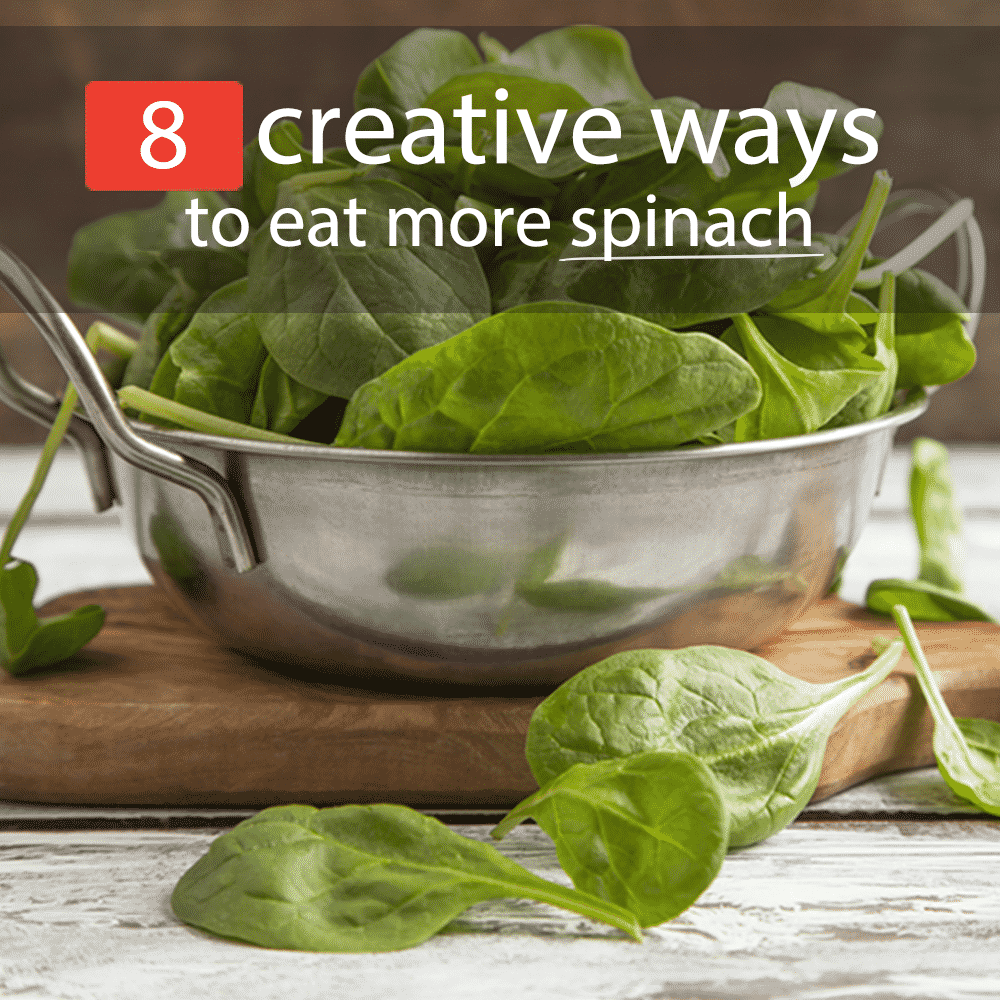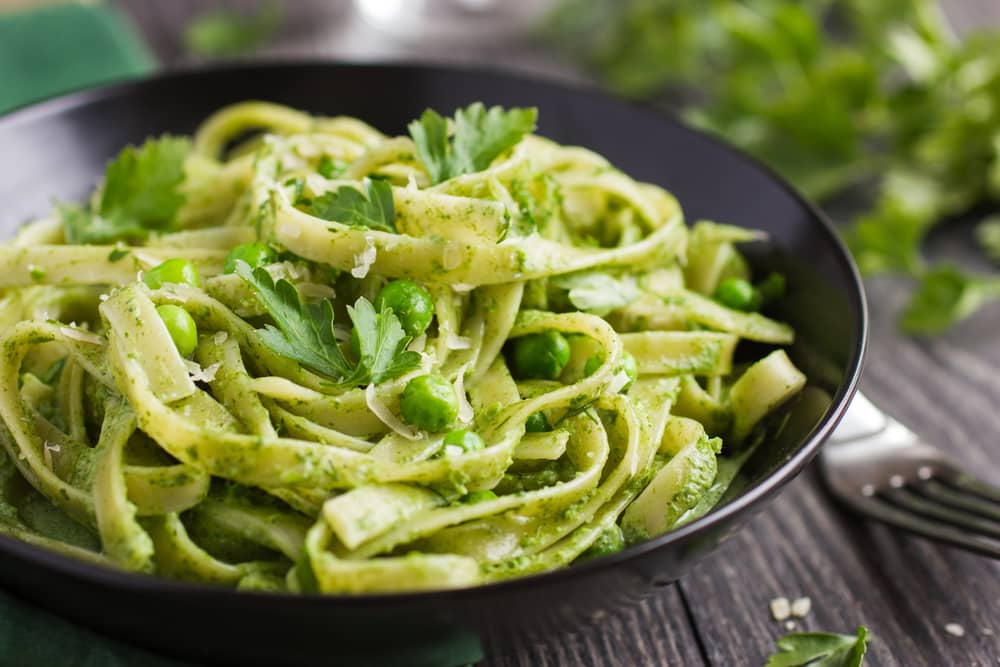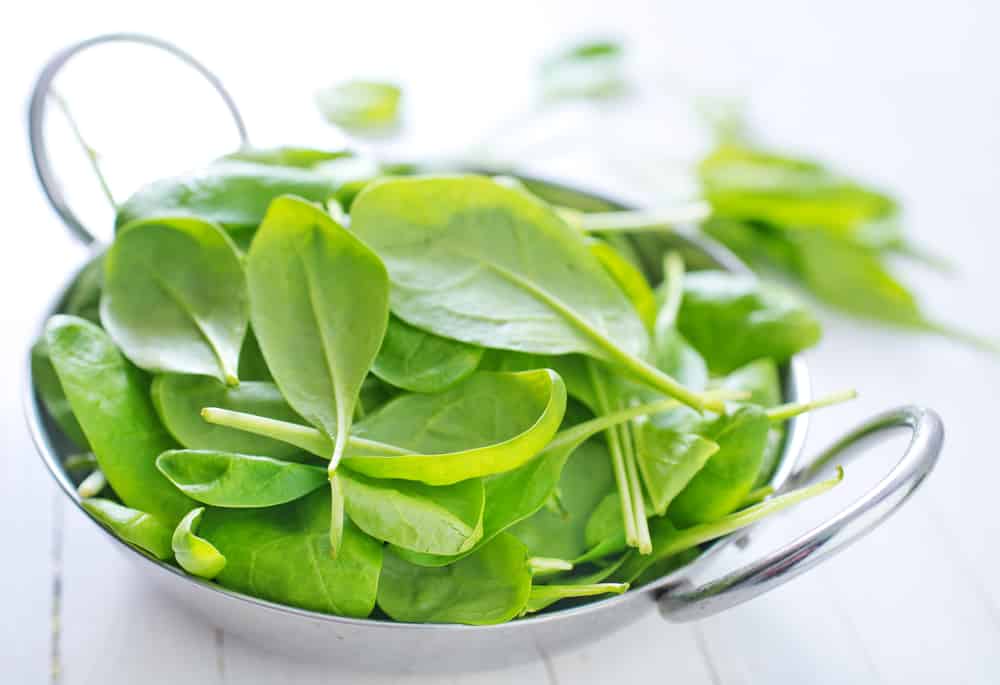Getting your two to three servings of vegetables in every single day is tough. Especially when you aren’t a huge fan of vegetables, whether raw or cooked. One way to train yourself to eat more vegetables every day — during all meals and snacks — is to incorporate veggies into other foods to mask their more earthy flavors. Spinach is the perfect example. It’s so versatile that it can almost go with anything.
Still, you have to at least try to get creative with your veggies if you really want to absorb all their health benefits. So we’ve put together a few suggestions for things you can prepare that include spinach as a main ingredient. Try them all and see how easy it is to eat more vegetables every day of the week.

1. Toss together a spinach-based salad
One of the easiest and most traditional ways to introduce more spinach into your diet is to use it as a salad base. You can create vegetable salads with a verity of dark green leafy vegetables, such as spinach or kale, but can also use lettuce — though it’s much less nutritious.
Spinach leaves, baby spinach in particular, are small and easy to work with. Eating them fresh, and topping them with vegetables, grains, and a light vinegar-based dressing, can turn a bowl of leaves into something truly delightful.
Think salads are painfully boring? You clearly haven’t taken the time to experiment with the right food combinations, textures, colors, and flavors. Below is the recipe for a spinach-based salad you won’t believe is actually good for you — and extremely simple to make.
Protein-Packed Spinach Salad (Dinner size — serves 1)
Add the following ingredients to a large bowl, toss with dressing, and enjoy!
- 2 cups fresh spinach, rinsed, torn into pieces
- 1/2 hard-cooked egg
- 1/2 cup sliced strawberries
- 1/4 cup onion, thinly sliced
- 1/4 cup almonds
- 1 slice turkey bacon, crumbled
- 1/4 cup seasoned croutons
- Olive oil and vinegar dressing
If you want, you can leave the fruit out, or substitute with a different fruit or vegetable, such as raspberries, mandarin oranges, or carrots.

2. Put it in your pasta
The problem with many pasta dishes is that they come loaded with sauce. Usually, there aren’t many vegetables involved. Even if there’s animal protein mixed in, you’re still missing out on essential nutrition — and you’re getting a lot of extra salt in the process. Try this sauce-free, tasty spinach and garlic pasta. There’s a little butter, but a tablespoon won’t hurt.
Parmesan Spinach Pasta (Serves 4)
- 8 oz. whole grain pasta, uncooked
- 1 tablespoon butter, unsalted
- 1 clove garlic, minced
- 6 cups baby spinach
- 1/2 cup parmesan cheese, shredded
Boil water in a large pot. Add pasta, cook until al dante, and drain. Save 1 cup of the pasta water.
In the same pot, melt butter, add garlic and cook 3 minutes. Add pasta and spinach, toss, and cook until the spinach wilts. Add 1/2 cup of leftover pasta water if the pasta begins to dry out. Mix in 1/4 cup cheese and stir until combined.
Add pasta mixture to a large bowl, garnish with leftover 1/4 cheese, and serve hot.
3. Create a spinach-based hummus
Hummus, made from chickpeas, is a protein-rich and healthy alternative to high-fat and high-salt dips like Ranch or sour cream-based vegetable dips. As long as you don’t eat the whole container in one sitting — it’s quite filling, so that’s highly unlikely — you’ll actually benefit from dunking your veggies. Adding spinach packs even more fiber, protein, and essential vitamins into the mix.
Spinach and Basil Hummus Dip (yields about 2 cups)
- One 15-ounce can garbanzo beans [chickpeas], drained
- 2 cups fresh spinach leaves, washed
- 1 cup fresh basil leaves
- 1 tablespoon olive oil
- 2 tablespoons water (to start)
- 1 1/2 teaspoons lemon juice
- 1 tablespoon tahini
- Salt and pepper to taste (optional)
Add all ingredients to food processor and blend until smooth, about 2-3 minutes. Scrape down sides of the food processor and add an additional tablespoon of water if the hummus is thicker than you desire. Process again and then transfer into a bowl.
Serve your spinach-rich hummus with fresh vegetables, French bread slices, or whole grain crackers.

4. Add it to your pizza
Craving pizza, but need something that’s actually healthy? Skip the salty, larger than life delivery pizza and make your own small, fresh, and delicious pizzas at home.
Spinach and Artichoke Flatbread Pizza (Serves 4 — don’t forget to share!)
- 1 garlic clove, minced
- 1 tablespoon fresh parsley, minced
- 6 tablespoons olive oil (divided)
- Two 8-inch flatbreads, round
- 1/2 cup shredded mozzarella cheese
- 4 tablespoons shredded parmesan cheese (divided)
- One 14-ounce can of artichokes, drained
- 1/2 cup cherry tomatoes, halved
- 2 cups fresh baby spinach leaves, chopped
- 1/2 teaspoon dried basil leaves
- Salt and pepper to taste
Preheat oven to 425 degrees (F). Line a baking sheet with parchment paper. In a large bowl, combine garlic, parsley, and 4 out of 6 tablespoons of olive oil. Evenly spread the mixture over the top surface of both flatbreads. Sprinkle mozzarella and 2 tablespoons of parmesan cheese over both.
Toss artichokes, tomatoes, and basil with remaining 2 tablespoons olive oil. Add mixture to the top of the cheese on both flatbreads. Add the rest of the parmesan cheese to the top of the flatbreads to cover the mixture.
Arrange loaded flatbreads onto baking sheet and bake 10 to 12 minutes or until the flatbread pizzas look golden and crispy. Serve warm for optimal flavor.
5. Sprinkle it into an omelette
There is no better way to start the day than with a vegetable and protein filled omelette. This egg white omelette is a lighter version of the traditional omelette. The spinach and feta cheese enhance its flavor while providing extra nutritional value. Eat this omelette for breakfast, and there is no way you will be hungry again until it’s time for lunch.
Spinach and Feta Egg White Omelette (Serves 1)
- 3 egg whites
- Salt to taste (optional)
- 1/2 cup fresh spinach, chopped
- 4 cherry tomatoes, sliced
- 2 tablespoons feta cheese, crumbled
- Cooking spray
Heat skillet over medium heat. Coat with cooking spray.
In a bowl, whisk egg whites and salt. Pour egg mixture into the heated skillet and swirl until eggs cover the whole bottom surface. Cook 2 minutes.
Arrange spinach, tomato slices, and feta cheese on the middle of the eggs in the skillet. Cook until the very edges of the eggs start to curl up, about 3 more minutes. Use a spatula to loosen the eggs from the skillet and fold in half.
Continue cooking until cheese is melted, about 3 additional minutes. Transfer onto a plate and serve with fresh fruit and whole grain toast.
If you want, you can add other ingredients to this omelette as well for even more flavor, such as garlic, onions, or a selection of herbs of your choosing.

6. Make it a sandwich staple
A plain hamburger with cheese and ketchup isn’t much to get excited about. That’s why getting creative with your sandwich add-ons is essential if you want to reap the benefits of multiple foods in one delicious meal. Adding spinach to this veggie burger creates a unique flavor and texture you will want to recreate again and again.
Veggie Burger with Spinach, Tomato, and Onions (Serves 1)
- 1 whole grain bun, halved
- Mozzarella or provolone cheese
- 1/2 cup spinach
- Mediterranean chickpea burger patty (cooked)
- 1 tomato slice, sliced thick
- 1 onion slice, thin
- 1/4 avocado, mashed
Stack bottom bun with cheese, spinach, veggie burger patty, tomato, and onion. Spread mashed avocado on inside of top bun and add to the top of the sandwich.
Serve with homemade baked sweet potato fries, kale chips, roasted potatoes, or a small side spinach salad.

7. Blend it into a smoothie
Adding spinach to a smoothie increases its protein and fiber content, and it’s easy to include the whole leaf without having to worry about excluding nutrients by removing a peel or stem. There are plenty of healthy ways to sweeten a green smoothie — try this one out and see how you like it.
Spinach, Yogurt, and Kale Smoothie (Serves 1)
- 1/2 cup honeydew, cubed
- 1/2 plain Greek yogurt
- 2 tablespoons water
- 2 cups spinach
- 1/2 cup kale
- 10 ice cubes
Add honeydew, yogurt, water, spinach, and kale to a blender. Pulse until smooth. Add ice and repeat. Suggested sweeteners (optional): honey, 1/2 banana, apple slices, figs).
You can take your smoothie with you on the go, or you cam casually sip it as you catch up on reading other Bembu articles you might have missed!
8. Stir it into your soup
Whether it’s cool outside or you are just in the mood for something warm and filling for dinner, soup is the perfect way to eat more vegetables when all their tastes are blended together. This soup also includes beans, which add a unique texture and more nutrition to your bowl.
White Bean and Spinach Soup (Serves 4)
- 1 tablespoon olive oil
- 2 cloves garlic, minced
- 1 small onion, chopped
- 1 cup dry white wine
- 32 ounces vegetable stock
- One 15 ounce can cannellini beans, rinsed and drained
- 3 cups baby spinach
- 1 cup fresh ground parmesan
Heat oil in a large pot over medium heat. Add garlic and onion and stir, cooking 2 minutes. Add white wine and vegetable stock and bring to a boil. Let simmer 5 minutes or so.
Mix in beans, stir, and let simmer until tender, about 5 more minutes.
Add fresh spinach and parmesan cheese just before serving. Stir until spinach is wilted, and then transfer to bowls and serve immediately.

Health benefits of spinach
So why is it so important that you eat more spinach? Wouldn’t it just be easier to make a pizza without them, or enjoy a plate of buttered noodles without vegetables mixed in? It turns out spinach is one of the healthiest vegetables you can eat — and you definitely do not want to miss out on its many benefits.
These leaves may not be the superfood celebs and dieters can’t get enough of, but it’s still extremely valuable for your health. Take a look at its nutrient profile, and all the possible ways it could benefit you in the long-term.
Nutrient profile
(Amounts per 1 cup of raw spinach.)
- Calories: 7
- Protein: 0.86 grams
- Carbohydrates: 1.09 grams
- Fiber: 0.7 grams
- Iron: 0.81 miligrams
- Potassium: 167 miligrams
- Vitamin K: 144.9 micrograms
- Vitamin A: 2813 international units
Cancer prevention
Many plant foods offer specific protective health benefits that animal products cannot. Spinach and other green vegetables contain a chemical substance called chlorophyll. Some research suggests pairing spinach with grilled foods can reduce the carcinogenic effects of compounds formed when a food is grilled at a high temperature.
Improved blood pressure
If you suffer from high blood pressure, eating spinach regularly could improve your readings. Spinach is high in potassium, which can reduce the negative effects of sodium in your blood. Not eating enough potassium puts you at a much higher risk of suffering high blood pressure and the heart-related consequences that come with it. Maintain a low-sodium diet and consume foods rich in vitamins and minerals to stay healthy in the long-term.
Stronger bones
Calcium isn’t the only mineral essential for bone health. In fact, how readily your bones absorb and use calcium depends on the other nutrients you consume, such as vitamin K — which spinach has plenty of. Consuming enough vitamin K improves the amount of calcium your bones absorb. It also might decrease the amount of calcium excreted through urine. Strong, healthy bones reduce the probability of bone fractures and making fitness and health safer and more enjoyable overall.
Healthy digestion
Spinach has a high water and fiber content compared to its density and size. This means a few servings can do a lot to prevent constipation and promote a healthy digestive system. Eating roughly 25 grams of fiber per day can keep your gut healthy and even help fill you up, so you’ll be less tempted to eat foods high in sugar and fat.
Adding more vegetables into your diet can completely turn your life around. With enough recipes at your fingertips and the curiosity to seek out new ones every week, you’ll be able to increase your fiber and protein intake in no time. Dark green leafy vegetables don’t have to be boring — and you don’t have to add large amounts of salt- and fat-saturated condiments to them to enjoy their health benefits. Incorporate more spinach into your diet and never get bored with a meal ever again.


